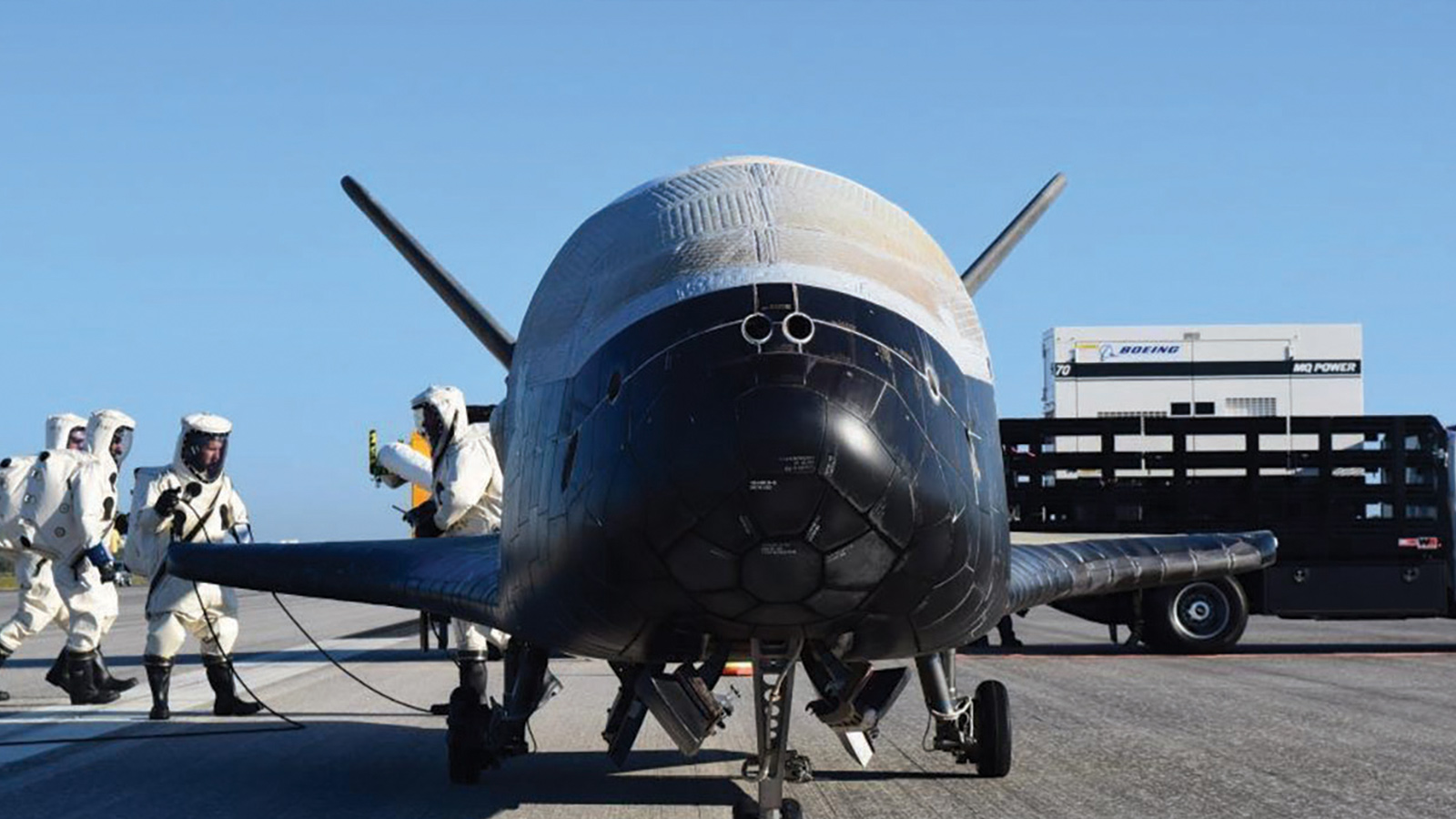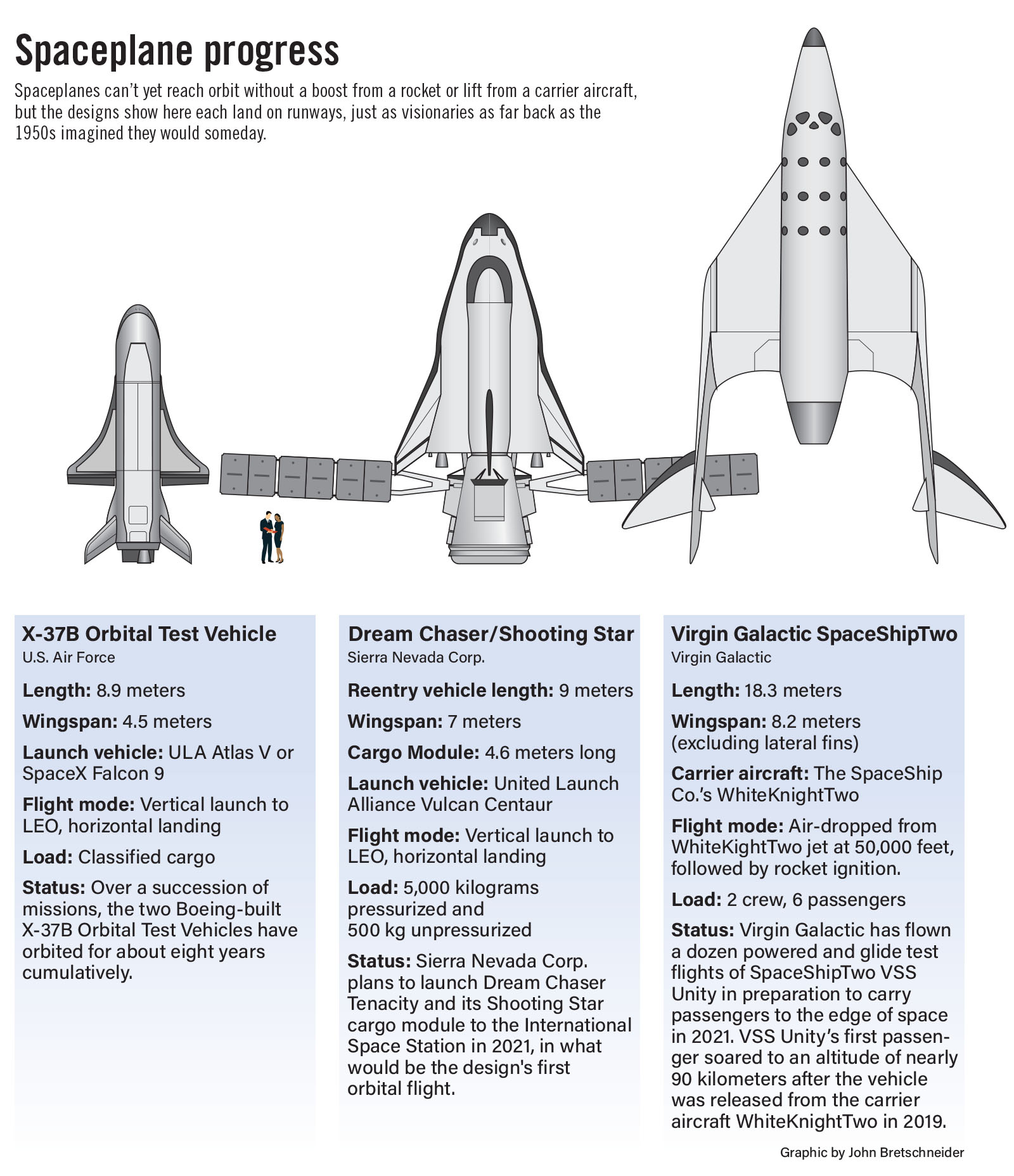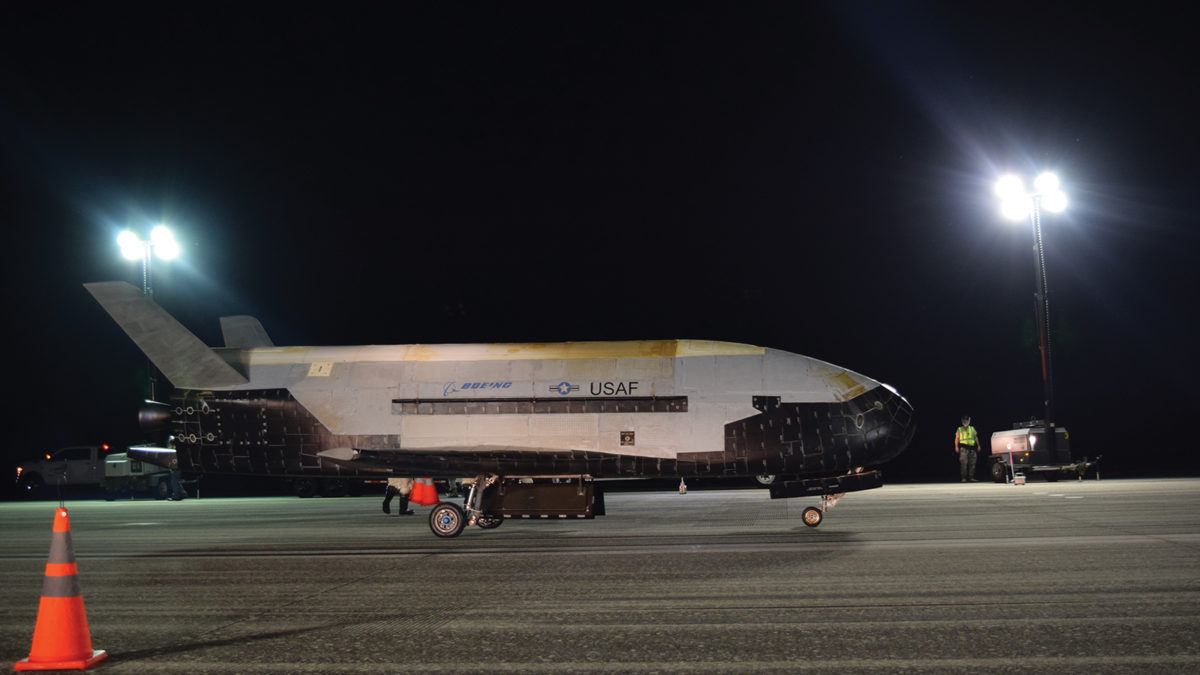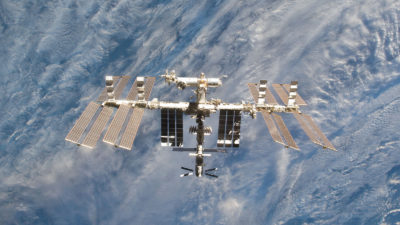Spaceplane catalyst
By Debra Werner|October 2020
No one without the right clearance knows exactly what the U.S. Air Force’s X-37B spaceplanes do in orbit, but it must be a lot given the cumulative years they’ve spent up there. The vehicles are sparking a resurgence of interest in spaceplanes as a necessary ingredient for expanding society to space. Debra Werner tells the story.
Less than five minutes after liftoff in May, the United Launch Alliance webcast cut away from the Atlas V rocket before its payload shroud opened to expose its cargo: a U.S. Air Force X-37B spaceplane carrying orbital experiments housed inside its payload bay. The online audience was treated to Boeing, ULA, Air Force and U.S. Space Force leaders thanking first responders for their work during the covid-19 pandemic.
The Air Force, which owns two X-37Bs, and the Space Force, which flies them, like to offer tantalizing glimpses but few details of the autonomous spaceplanes that have spent about eight years in orbit over six missions. The spaceplanes make cameos in the first Space Force recruitment videos released in May, coming in for landing and on a runway surrounded by people in hazmat suits with sensors to check for noxious vapors.
Air Force Secretary Barbara Barrett lauded X-37B’s unique capabilities as an experimental platform during a May webinar put on by the Space Foundation but said little about what it tests, aside from identifying a handful of NASA and military research laboratory experiments. Boeing declined my requests for interviews on the X-37B or the merits of spaceplanes in general, and its customer, the Air Force, said “coordinating an interview will take time” and had not scheduled one as of Sept. 21.
In spite of the mystery, the U.S. National Aeronautics Association announced in August that it had selected the X-37B, which it called “the world’s only reusable, autonomous spaceplane,” to have its name engraved on the prestigious Robert J. Collier Trophy, whose most famous past recipient is the GPS constellation.
The vehicles are serving as an advertisement for the type of spaceplane likely to play an increasingly important role as entrepreneurs, Fortune 500 companies and NASA managers seek to extend the Earthly economy, and someday possibly even our society, into orbit.
“You can count on spaceplanes flying people and cargo to the edge of space or to low-Earth orbit and back very soon,” predicts Bobby Braun, a former NASA chief technologist and now director for planetary science for NASA’s Jet Propulsion Laboratory in California. “Spaceplanes are here, and they’re here to stay.”
By edge of space and soon, he means Virgin Galactic’s SpaceShipTwo, an air-launched suborbital spaceplane that the company plans to launch with customers for the first time in 2021. On the orbital side, he means Sierra Nevada Corp.’s Dream Chaser. Like an X-37B, it will be boosted toward space atop a conventional rocket inside a payload fairing. If all goes as planned, Dream Chaser will transport cargo for NASA to and from the International Space Station starting in 2021.
Defining spaceplanes
Spaceplane discussions often begin with definitions. Not everyone considers X-37B, SpaceShipTwo and Dream Chaser spaceplanes. Some preserve the term for single-stage-to-orbit vehicles that take off from a runway, travel to orbit and return to a runway. Others include air-launched spacecraft as long as they have wings to maneuver and glide through Earth’s atmosphere on the way back from orbit to a runway.
If vehicles that fit those definitions are eventually built and flown hundreds of times with minimal repair and maintenance between flights, they could slash the cost of space transportation and speed point-to-point travel on Earth.
Few expect significant savings with spaceplanes launched atop throwaway rockets that can cost $100 million or more.
Space pioneers will need 10 to 100 times more flights to orbit, “if you are serious about blowing open a low-Earth-orbit economy,” says Adam Dissel, president of Reaction Engines Inc., the U.S. subsidiary of the United Kingdom air and space propulsion company that aspires to crack the spaceplane riddle. “You’ve got to move to more aircraft-like operations,” he says. But imagine if an aircraft took off and landed safely 98% or 99% of the time. Those figures are the best one can expect from most of today’s expendable or partially reusable rockets, and that’s not nearly good enough for carrying precious cargo. “We have to move the needle on reliability,” Dissel cautions.
In addition to cost and reliability, there are convenience and comfort to consider.
“I’m partial to vehicles that land on runways instead of having to recover people somewhere else with helicopters and boats,” says Janet Kavandi, SNC’s senior vice president for space systems business and a former NASA space shuttle astronaut.
Spaceplanes can adjust their angle of atmospheric reentry to reduce the forces on passengers or cargo.
“Depending on the design of the capsule, coming back from orbit you might pull 8 or 9 G’s,” Braun says. “If you’re in Dream Chaser, it’s more like 2 G’s.” (In fact, Dream Chaser is designed for atmospheric reentries of 1.5 G’s.)
Spaceplane advocates also bring up maneuverability.
“Because it has wings, it could do interesting things in terms of changing its orbit by using lift and drag in a way that a simple capsule would have a hard time doing,” says Peter Garretson, retired Air Force lieutenant colonel and now a senior fellow for defense studies at the American Foreign Policy Council in Washington, D.C.
On the return trip, if there is a problem at one airport, a spaceplane can adjust its trajectory to glide toward another airport.
Stefan Powell, co-founder and chief technology officer of Dawn Aerospace, a New Zealand space transportation startup, says compared with rockets, spaceplanes will be “in every way a safer, more reliable, more efficient way of transportation.”
Zero to Mach 25
That’s the promise. To date, in spite of tens of billions of dollars spent by governments and corporations and decades of research and development around the world, no one has flown a single-stage-to-orbit spaceplane or even managed to release a spaceplane from an aircraft and send it to orbit.
Instead, astronauts, satellites and cargo are typically boosted toward orbit on lightweight rockets filled with propellant that claims up to 90% of their takeoff weight. But reaching orbit in a single-stage spaceplane and landing with a quick turnaround comes with sizable challenges. Such vehicles would have to be durable enough to survive multiple reentries in Earth’s atmosphere, and they would need efficient propulsion for takeoff, ascent through the atmosphere and spaceflight because wings and landing gear add weight.
“What propulsion system is viable from a velocity of zero to Mach 25?” asks Dallas Bienhoff, founder of Cislunar Space Development Co., a Virginia startup, and former Boeing space architect and project manager. “And what materials are viable for reentry without requiring months for inspection and repair like the space shuttle?”
This is his way of suggesting that no one has answered those questions with certainty. Engineers are beginning to tackle those challenges. The highest profile effort is underway at Reaction Engines, which designed Skylon, a single-stage-to-orbit spaceplane powered by SABRE, for Synergetic Air-Breathing Rocket Engine. SABRE’s key innovation is a precooler, a heat exchanger to chill and compress incoming air before funneling it into the engine. Instead of carrying liquid oxygen on board like most rockets flying today, SABRE would pull oxygen from the air, vastly reducing its takeoff weight.
“That’s now a savings I can pass onto a vehicle that can afford the weight penalties of wings, landing gear or more robust structural margin,” says Dissel.
To make air breathing work, though, the air must be cooled. An aircraft traveling beyond Mach 3.5 or Mach 4 would make its surrounding air hot enough to melt engine components. SABRE’s precooler, tested on the ground in 2019 at speeds as high as Mach 5, solves the problem by reducing the temperature of incoming air and injecting the heat pulled from the air into its SABRE engine. “It’s a usable bit of energy to help run your engine,” Dissel says.
The next step for Reaction Engines is to demonstrate the SABRE engine cycle on the ground, proving it can move thermal energy from the air to the engine.
Other startups have competing designs for spaceplanes and spaceplane propulsion.
Polaris Raumflugzeuge, a spinoff of DLR, the German Aerospace Center, performed the first flight in April of a 2.5-meter model of Aurora, a flying wing propelled by a kerosene-fed turbojet engine. Eventually, the company would like to scale up the design to carry people and launch satellites. But Aurora initially would be limited to suborbital flights, and an expendable upper-stage would have to be added to loft satellites into orbit.
New Zealand’s Dawn Aerospace is developing Mk-II Aurora, a 4.8-meter-long air-launched spaceplane scheduled to begin flight tests with a jet engine later this year. If all goes as planned, Dawn Aerospace will add a rocket motor for further testing in 2021.
Flying testbed
Meanwhile, the X-37Bs have proved that an autonomous spaceplane can remain in orbit for years at a time; the design’s longest mission was 780 days. How the design operates, the U.S. Defense Department won’t say beyond disclosing its dimensions and the fact that it is powered by gallium arsenide solar cells that charge lithium-ion batteries.
Over multiple flights, X-37Bs have tested advanced guidance, navigation and control, thermal protection, avionics, high temperature structures and seals, conformal reusable insulation, lightweight electromechanical flight systems, advanced propulsion, advanced materials and autonomous orbital flight, reentry and landing, according to an Air Force fact sheet.
During the first three flights, the Air Force demonstrated technologies for long-duration reusable space vehicles with autonomous reentry and landing systems, an Air Force spokesman said by email.
The fourth flight in 2015 housed an Aerojet Rocketdyne Hall-effect thruster and NASA research on the effect on various materials of long-term exposure to temperature extremes and space radiation.
Three cubesats piggybacked on and were released from the fifth X-37B, which reached its highest-inclination orbit. An Air Force Research Laboratory satellite to test oscillating heat pipes, tubes containing liquid to help cool electronic devices, also flew on Orbital Test Bed-5, as the flight was known.
The sixth flight, launched in May and still in orbit as of late September, houses more experiments than any of the prior missions. One is — or was, if it’s been released already — the FalconSat-8, a 136-kilogram U.S. Air Force Academy satellite to test thrusters, cameras, antennas, reaction wheels, carbon nanotube cables and a flywheel energy storage device. (The X-37B released a small satellite on May 30, but space watchers aren’t certain that was FalconSat-8, and the Air Force had not answered my question as of Sept. 21.) NASA also sent another materials-testing experiment and a payload to show how space radiation affects food seeds. In addition, the U.S. Naval Research Laboratory is conducting an experiment to turn solar power into radio frequency microwave energy, which someday could be transmitted to the ground, to another spacecraft or to a lunar or Martian habitat.
“We’ve gained a lot of information in the decade we’ve been operating” X-37Bs, according to Randall Walden, who runs the Air Force Rapid Capabilities Office that manages the X-37B program, speaking in an August webinar put on by the Mitchell Institute for Aerospace Studies in Virginia. “It’s provided unique and relevant insight into some of the newer technologies that would actually go to space and informs how they would build those systems,” he said.
Air Force officials don’t reveal all the technology they are examining on board X-37B, but the ability to test satellite technologies and bring them home to examine would be particularly useful for reconnaissance or missile warning.
“You’re looking at programs that are going to cost billions of dollars and take a long time,” says Brian Weeden, program planning director for the Secure World Foundation, a Washington think tank. “Being able to flight test individual components or technologies ahead of time makes a lot of sense.”
The military doesn’t disclose the X-37B’s orbit or the orbits of the cubesats it has launched over the years. Hobbyist observers equipped with telescopes have spotted the spaceplanes at altitudes of 270 to 450 kilometers and inclinations of 37 to 55 degrees, meaning they travel over latitudes between 55 degrees south and 55 degrees north, says Jonathan McDowell, an astrophysicist at the Harvard-Smithsonian Center for Astrophysics in Cambridge, Massachusetts.
The X-37B is not likely to be testing electro-optical cameras because it does not travel in a sun synchronous orbit where consistent lighting would make it easier to detect changes by comparing images. Instead, observers suspect the spaceplane could test radars, hyperspectral imagers or some type of signals intelligence device, meaning a sensor to detect electronic signals coming from sources like ground-based radars.
“I honestly don’t know, but my guess is that it’s testing technologies for ground surveillance, intelligence and reconnaissance,” says Weeden, former director of a U.S. Air Force orbital analyst training program.
Dream Chaser and SpaceShipTwo
Compared with the X-37B, the other two spaceplanes nearing takeoff, SNC’s Dream Chaser and Virgin Galactic’s SpaceShipTwo, are open books.
Dream Chaser will carry up to 5,500 kilograms of pressurized and unpressurized cargo in its 9-meter-long lifting body and 4.6-meter-long trunk called Shooting Star. The first flight of Tenacity, the first orbital Dream Chaser as opposed to the engineering test vehicle, is scheduled to travel to the International Space Station on a United Launch Alliance Vulcan Centaur rocket in 2021.
Each Dream Chaser is designed to make 15 or more flights and to fit a variety of launch vehicles including the Atlas V. Under the Commercial Resupply Services 2 contract NASA awarded to SNC in 2016, Dream Chaser will remain docked to the International Space Station for as long as 75 days before disposing of 3 metric tons of trash, about half a metric ton more than Northrop Grumman’s Cygnus capsule, to burn up in the atmosphere and delivering up to 1,925 kilograms of cargo to the runway at the Kennedy Space Center’s Shuttle Landing Facility on Florida’s Merritt Island. Although NASA is hiring Dream Chaser to transport cargo, the spaceplane was designed originally to carry astronauts. It could eventually serve as an orbiting laboratory or a government or commercial transport vehicle.
“We’re focused on getting this particular vehicle to the space station and back,” says John Wagner, a retired U.S. Air Force colonel and SNC’s vice president for national security space. “Once we show everyone we can do this, cargo to station is just the beginning. Then, we envision other opportunities for Dream Chaser including crewed missions.”
As for Virgin’s SpaceShipTwo Unity, it is poised for takeoff in early 2021 with founder Richard Branson on board to attest that the experience of traveling to the fringes of space lives up to the Virgin brand’s reputation for customer service.
Prior to welcoming Branson on board, Virgin Galactic plans to conduct two powered test flights from Spaceport America in New Mexico of the 18.3-meter-long carbon-fiber vehicle with twin tail booms that fold down to act like wings in the atmosphere.
Suborbital tourism is Virgin Galactic’s first market, but the company’s long-term goal may be high-speed point-to-point transportation. Virgin Galactic and its subsidiary, The Spaceship Co., are working with NASA and Boeing, one of the firm’s investors, to develop commercial planes able to travel Mach 3.
While that is not as fast as the hypersonic spaceplanes that could someday deliver passengers from New York to Tokyo in a couple of hours, it would speed the journey. “If you can achieve low-Earth orbit, you can get anywhere,” Braun says.
Related Topics
Commercial Spaceflight“You can count on spaceplanes flying people and cargo to the edge of space or to low-Earth orbit and back very soon. Spaceplanes are here, and they’re here to stay.”
Bobby Braun, NASA’s Jet Propulsion Laboratory













